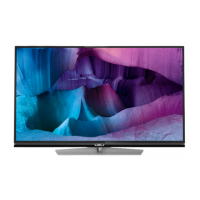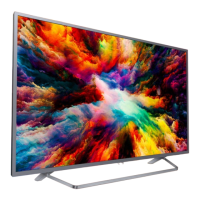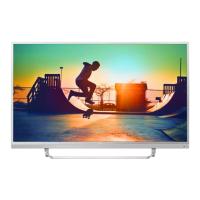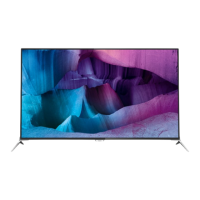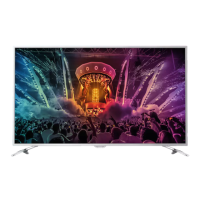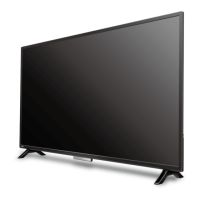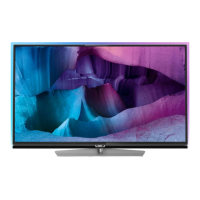
Do you have a question about the Philips 7150 Series and is the answer not in the manual?
| Display Technology | LED |
|---|---|
| Smart TV | Yes |
| Operating System | Android TV |
| HDMI Ports | 4 |
| USB Ports | 2 |
| Refresh Rate | 60 Hz |
| Audio Output Power | 20W |
| Sound | Dolby Atmos |
| Resolution | 3840 x 2160 |
| HDR | HDR10+, Dolby Vision |
| Voice Control | Google Assistant |
| Connectivity | Wi-Fi, Bluetooth |
| Screen Size | 55 inch, 65 inch |
| Ambilight | Yes (3-sided) |
Describes the TV's Ultra HD display and picture quality enhancement.
Details the Android TV features, apps, and connectivity.
Explains how to access and use pre-installed and downloaded applications.
Highlights the TV's capability for playing games from various sources.
Guides on accessing rental videos and on-demand content.
Explains how to pause live TV and record broadcasts using USB storage.
Describes how to access social network messages directly on the TV.
Introduces the Ambilight feature for enhanced visual experience.
Explains extending Ambilight experience with Philips Hue bulbs.
Emphasizes the importance of reading safety instructions before use.
Provides instructions for mounting the TV stand and wall bracket.
Offers advice on optimal TV placement for viewing and Ambilight effect.
Details how to connect and handle the power cable safely.
Guides on connecting the antenna cable for TV signal reception.
Explains how to connect a satellite dish for reception.
Stresses the necessity of internet connection for Smart TV functionality.
Provides step-by-step guides for wireless and wired network connections.
Details how to view and configure network settings like Static IP.
Explains connecting to other network devices like computers.
Guides on accessing photos, music, and videos stored on a computer.
Offers general advice on connecting devices for optimal quality.
Explains how to use a CI+ CAM module for premium channel access.
Guides on connecting set-top boxes and satellite receivers.
Details connecting and configuring home theatre systems via HDMI ARC.
Explains connecting a Blu-ray Disc player for playback.
Guides on connecting a DVD player via HDMI or SCART.
Explains how to connect headphones and adjust volume.
Provides connection methods for game consoles via HDMI, YPbPr, or SCART.
Guides on connecting wireless gamepads for gaming.
Explains connecting and formatting USB hard drives for pause/record features.
Details connecting and configuring USB keyboards for text input.
Explains viewing media files from USB flash drives.
Guides on connecting digital cameras to view photos.
Explains how to connect camcorders via HDMI or SCART.
Guides on connecting a computer to use the TV as a PC monitor.
Explains how to turn the TV on and put it into standby mode.
Guides on adjusting or switching off the Philips logo brightness.
Describes using the TV's joystick key for basic operations without the remote.
Explains how to set the TV to automatically switch to standby.
Details the automatic switch-off timer and how to deactivate it.
Provides an overview of the remote control's top, middle, and bottom buttons.
Explains the functionality of the remote control's keyboard layouts (Qwerty, Azerty, Cyrillic).
Details the pairing process between the remote and the TV.
Explains the TV's infrared sensor for remote control reception.
Guides on replacing the remote control's batteries.
Provides instructions for cleaning the remote control.
Explains how to open and navigate the Home menu and its sections.
Details how to open, filter, and search channel lists.
Guides on tuning, switching, and locking channels, and parental rating.
Explains creating, renaming, removing, and reordering favourite channel lists.
Guides on viewing and navigating TV guide information and recordings.
Explains how to open, select pages, and use Teletext features.
Details how to use interactive TV features like HbbTV.
Introduces Top Picks for program recommendations and Terms of Use.
Explains the feature that recommends currently popular TV programs.
Guides on accessing missed TV programs and on-demand content.
Explains how to rent movies from an online video store.
Guides on switching between connected devices and watching their content.
Explains how the TV detects new devices and assigns icons.
Describes initiating playback from connected devices using the remote.
Introduces the TV's app features and where to find them.
Guides on installing applications from the Philips App Gallery or Google Play.
Explains how to launch and stop applications on the TV.
Guides on viewing media files from USB devices.
Explains accessing media files from network-attached storage.
Outlines requirements for watching 3D content and compatible glasses.
Provides guidance on wearing and viewing with 3D glasses.
Details automatic switching, stopping 3D, and 2D to 3D conversion.
Offers recommendations for the best 3D viewing experience.
Provides instructions on cleaning and maintaining 3D glasses.
Lists health warnings and precautions for 3D viewing.
Explains watching a TV channel in Multi View while viewing Text.
Details watching TV in Multi View while using an app.
Describes watching TV in Multi View while viewing HDMI device content.
Covers selecting picture styles, adjusting colour, contrast, and sharpness.
Details selecting sound styles, adjusting bass, treble, and surround modes.
Explains setting Ambilight styles, brightness, saturation, and advanced settings.
Covers energy-saving features like Energy Saving, Screen Off, and Light Sensor.
Explains EasyLink settings and remote control functions.
Guides on changing menu language, audio, and subtitle preferences.
Details features for deaf, hard of hearing, or visually impaired users.
Covers network connections, Bluetooth setup, and device management.
Explains how to access and adjust settings for Android Apps.
Guides on updating and manually installing channels via antenna or cable.
Explains installing satellites, Unicable systems, and managing channels.
Guides on updating TV software via USB or the internet.
Explains how to check the current TV software version.
Mentions the availability of open-source software used in the TV.
Provides details on various open-source licenses applicable to the software.
Informs about receiving announcements on new software or related issues.
Details the European Energy Label and product environmental information.
Lists power specifications, ambient temperature, and power-saving features.
Specifies the TV's operating system as Android 5.0 Lollipop.
Lists supported reception types, tuner bands, and digital/analogue playback.
Details screen size, resolution, and input resolution formats.
Provides physical dimensions and weights for different TV models.
Lists TV connections like HDMI, USB, CI+ slot, and Wi-Fi.
Lists sound specifications like 3D wOOx, HD Stereo, and output power.
Details supported multimedia connection types and playback formats.
Encourages TV registration for benefits like support and new product information.
Provides solutions for common TV issues related to channels, picture, sound, and connections.
Explains how to access on-screen help and download TV Help in PDF format.
Guides users to Philips' online support for troubleshooting and FAQs.
Advises contacting Consumer Care for support and repair, and warns against self-repair.
Covers important safety instructions regarding electric shock, fire, injury, and overheating.
Provides guidelines for cleaning and maintaining the TV screen safely.
Mentions Ultra HD display logo as a trademark.
Lists HDMI trademarks and their owner.
States Dolby trademarks and licensing.
Provides DTS patent information and trademark details.
Mentions DLNA trademarks and certification marks.
Lists Microsoft trademarks and PlayReady technology.
Mentions Wi-Fi Alliance trademarks.
Lists Kensington trademarks.
States that other trademarks belong to their respective owners.


